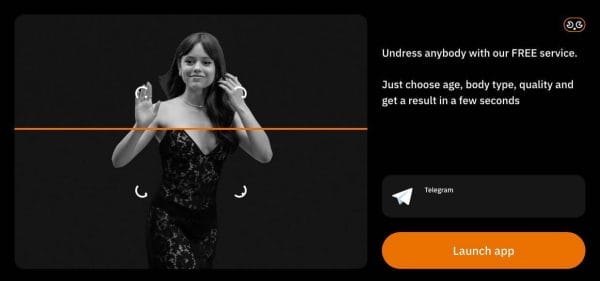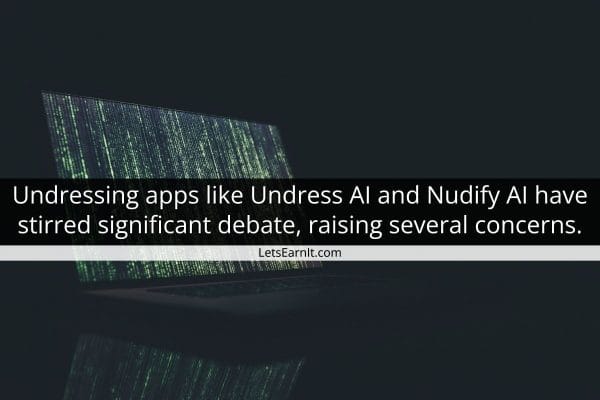From buzzworthy names like Undress AI, Deep Nude, and Nudify to the widely-discussed deepsukebe and nudifier, the AI landscape is brimming with tools designed to undress images of people.
In the ever-evolving Artificial Intelligence (AI) world, there’s always something new on the horizon, occasionally a cause for concern or even alarm.
Even if you’re not always up-to-date, this article may be a must-read.
Today, I’m diving deep into this realm, exploring the concerns it raises.
Settle in, and let’s begin!
What is “Undress AI”?
In the dynamic realm of Artificial Intelligence (AI), “Undress AI” stands out as one of the more controversial innovations.
At its core, “Undress AI” refers to AI-powered tools and software designed to digitally “undress” or remove clothing from images of individuals, often producing a simulated nude image.
These tools leverage advanced machine learning algorithms to analyze the input image and generate a version that appears as though the subject is undressed. The technology behind it is sophisticated, often relying on vast datasets of human anatomy to produce realistic results.
While the technological prowess of “Undress AI” is undeniable, it has sparked significant ethical and privacy debates.
Concerns range from non-consensual image manipulation to potential misuse in cyberbullying or harassment scenarios.
As with many cutting-edge AI tools, “Undress AI” presents a blend of innovation and ethical challenges that society must navigate.
The Growing Popularity of AI Nude Generators
The AI landscape is rapidly expanding, and one area gaining significant traction is the world of nude generators and undressing apps.
Searching for terms like “undress ai” or “ai nude generator” reveals many tools, from deepnude free to various nudifying apps.
These platforms, such as Undress App, capitalize on the allure of AI, promising transformative capabilities for images.

But what’s fueling this trend?
Maybe the innate human curiosity combined with the power of AI is driving this surge. As technology continues to push boundaries, these tools are becoming increasingly popular, offering services that many find captivating.
However, with this rise in popularity comes the pressing question:
Are we heading in an ethical direction with such tools?
The Ethical Concerns With Undressing Tools
The rise of AI has ushered in groundbreaking innovations, but with them come profound ethical and privacy challenges.
The emergence of AI tools designed to undress images is particularly alarming.
Many of these tools, upon closer inspection, lack transparency: they’re not backed by known companies, their domains are often hidden behind proxies, and their privacy policies and terms of use are vague at best.
While they boldly claim the ability to undress anybody, they ambiguously advise users to only upload images with consent, without any real means of enforcement.

The ethical implications are clear:
Is it right to use AI in such a potentially invasive manner?
As we grapple with these concerns, we must consider how we can safeguard our digital privacy.
How to Protect Your Privacy from Undress AI
In an age where Undress AI tools are becoming more prevalent, safeguarding our digital privacy is paramount.
Here are some steps to ensure your images remain private and protected from such technologies:
- Limit Public Sharing: Be cautious about where and how you share your photos online. Consider adjusting privacy settings on social media platforms to restrict who can view your images.
- Use tools like StopNCII.org: This tool helps individuals find and remove non-consensual intimate images from the internet. It’s a valuable resource for those concerned about their images being misused.
- Watermark Your Images: Adding a watermark can deter misuse of your photos. While it’s not foolproof, it can make it more challenging for AI tools to process the image accurately.
- Use Low-Resolution Photos: Undress AI tools often require high-resolution images to work effectively. By sharing lower-resolution photos, you reduce the chance of misusing them.
- Stay Informed: Awareness is a powerful tool. Stay updated about the latest in AI technologies and their potential implications. This knowledge can guide your online actions.
- Support Ethical Platforms: Choose to engage with online platforms that prioritize user privacy and have clear policies against the misuse of AI technologies.
- Report Misuse: If you encounter platforms or individuals misusing private images, report them. Many platforms have mechanisms to address such violations.
By adopting these practices, you can navigate the digital landscape with increased confidence, ensuring your images remain in safe hands.
Concerns with Undressing AI Apps
Undressing apps like Nudify AI have stirred significant debate, raising several concerns:
- Privacy Concerns: Manipulating personal photos without consent, especially those innocently shared online, challenges digital privacy norms.
- Non-consensual Content: These apps can produce explicit images without the subject’s knowledge, causing emotional and reputational damage.
- Cyberbullying Risks: Misusing these tools can aid cyberbullying, with victims seeing altered images of themselves online.
- Data Security: Questions arise about the storage, sharing, or potential sale of uploaded images, with data breaches being a constant threat.
- Legal Grey Areas: Many regions might classify the non-consensual distribution of explicit images under “revenge porn” laws, posing legal risks.
- Ethical Quandaries: The moral debate centers on whether the capability of a technology justifies its use, especially when it can manipulate images intimately.
- Voyeurism Concerns: Such apps could inadvertently promote and normalize voyeuristic behaviors.
- Misinformation Threat: In a world battling deepfakes, these apps further blur the line between reality and fabrication.
- Hidden Costs: Some apps, while initially free, might have in-app purchases, leading to unexpected expenses.

It’s crucial to navigate this space with caution and responsibility.
The risks of AI undressing technologies are just one issue to monitor. As artificial intelligence continues advancing rapidly across industries, many emerging capabilities warrant ethical scrutiny.
Other Challenging AI Technologies
Beyond the realm of undressing AI apps, numerous AI technologies have emerged, each with its unique challenges:
- Deepfakes: These create ultra-realistic yet entirely fabricated content, posing risks of misinformation and manipulation.
- Facial Recognition: Beyond unlocking phones, there are concerns about mass surveillance, biases, and misuse by oppressive regimes.
- Predictive Policing: This AI application can lead to racial profiling and privacy invasions, amplifying societal biases.
- Autonomous Weapons: These “killer robots” raise global ethical concerns about unintended engagements.
- AI Chatbots in Mental Health: The debate centers on AI’s ability to replicate human empathy in therapeutic settings genuinely.
- AI in Recruitment: There’s potential for biased hiring if the AI training data is skewed.
- AI Surveillance: Beyond facial scans, AI’s ability to analyze vast data can lead to privacy breaches.
- Emotion Recognition: The rising AI tools claiming to read emotions face scrutiny for accuracy and ethical use.
- AI in Healthcare: The balance between revolutionary diagnostics and the risk of misdiagnoses is delicate.
- Biased Algorithms: AI tools reflecting societal biases in their training data can produce skewed results.
While AI offers transformative potential, it is crucial to navigate its landscape with informed caution.
As we navigate this brave new world, let’s ensure we’re informed, aware, and constantly questioning.
Frequently Asked Questions (FAQs)
Is Undress AI Free?
While some “Undress AI” tools offer free versions or trials, many come with premium features that require payment.
Most applications offer high-quality images at a cost or charge you for faster image generation.
Additionally, even using a free service, you should consider the platform’s potential privacy risks and data handling practices.
Always exercise caution and do thorough research before diving into any AI tool.
Is Undress AI Real?
Yes, Undress AI is real.
It refers to AI-powered tools that digitally “undress” or remove clothing from images, producing a simulated nude version. These tools utilize advanced machine learning algorithms to generate these results.
While technologically impressive, they’ve sparked significant ethical and privacy debates.
Is Undress AI Safe?
Safety in the digital age is multifaceted.
When we talk about the safety of tools like Undress AI, we’re not just referring to its technical robustness but also its implications on privacy and misuse.
From a technical standpoint, many of these tools have secure platforms. However, the main concern lies in how they’re used. Misusing these tools can lead to privacy invasions, cyberbullying, and other malicious intents.
So, while the tool might be “safe” regarding functionality, its application can be dangerous.
Moreover, there’s the question of data storage and handling.
- Where does the data go when you use tools like the undress AI program or AI Undresser?
- Is it stored?
- Is it shared to train other similar AI engines?
These are critical questions that users need to consider.
Is Undress AI Legal?
Now, onto another pressing question: the legality of these tools.
The legal landscape surrounding undress AI and similar devices is complex and varies by region. In many jurisdictions, creating or distributing non-consensual explicit images can be illegal, even if generated by AI. This falls under “revenge porn” laws or similar legislation.
Furthermore, using someone’s likeness without their consent, especially in a manner deemed defamatory or invasive, can open up legal liabilities.
If you’re considering using or developing tools like AI undresser or undressing AI, it’s crucial to be aware of the laws in your region and only use the photos you have full rights over.
Concluding Thoughts on AI’s Ethical Landscape
The expansive world of AI continues to grow, introducing tools ranging from undressing apps and AI nudification to sophisticated deepnude generators.
These innovations are gaining traction, capturing global attention.
However, as we delve deeper into this domain, we must proceed with vigilance, informed awareness, and a dedication to ethical applications.
To my fellow bloggers, AI enthusiasts, and tech-savvy readers:
Let’s unite in our efforts to assess and guide these AI tools’ trajectories critically. Your insights and active participation in discussions are invaluable.
We can ensure a promising and conscientious AI future by raising collective awareness.
If this article resonates with you, please share it with your network. Together, we can spread awareness and ensure that AI’s future is bright and responsible.
Your Thoughts Matter
As we conclude this exploration into AI’s intricate world, I’m eager to hear your perspectives.
What are your thoughts on these emerging technologies and their ethical implications? Your insights and experiences enrich this conversation.
Please share in the comments or reach out directly.

Wow! I learned something new! I never realized that this type of technology had been developed. AI can be used for good and bad, just like almost everything else. Thank you for alerting us to the dangers of this application of AI technologies. There really is so much to consider in the ethical realm. Just because we CAN develop and publish something, does that mean that we SHOULD? Wow. just wow. Thanks again!
I’m glad that you’ve enjoyed the article, Scott.